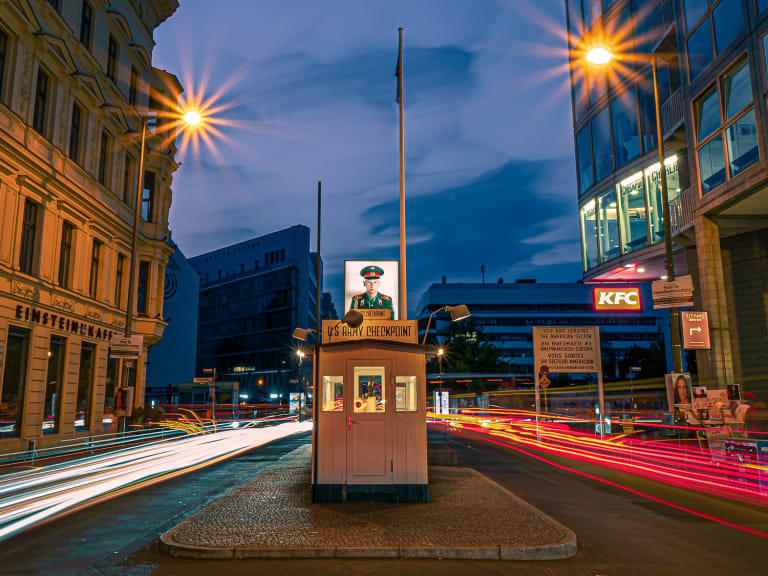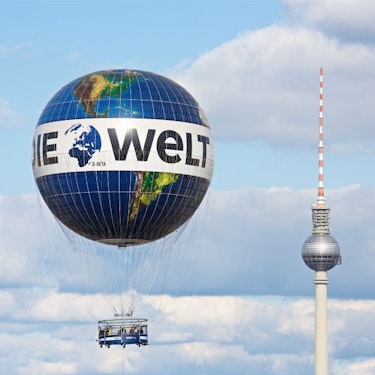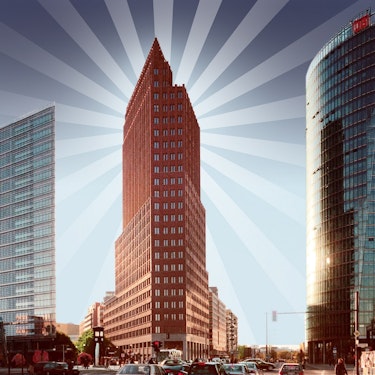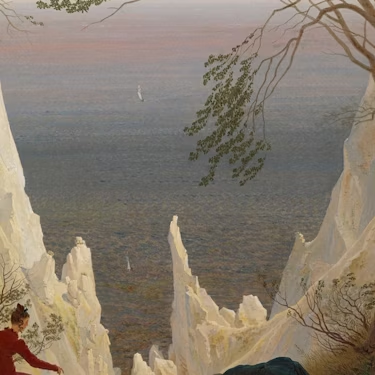More about: Berlin in 1 Day: a guidebook for getting the most out of your visit
Of course you can! With a bit of organisation you can see the essentials. 24 hours in Berlin is a good snack. If you don't have more time, I'm sure you'll be encouraged to come back, because there is so much to see and do in the German capital.
The city's history and skyline have been scarred by the wounds of the Second World War and the Cold War. However, Berlin has never given up and today it is famous for its atmosphere of freedom. Our tour starts in Mitte, the city's most central district.
Stroll at the foot of the Brandenburg Gate

An icon of the Cold War. Its silhouette could be seen from the nearby wall and citizens could not see it up close. When the wall was built, the Brandenburg Gate stood in the "no man's land" between east and west. Its construction dates back to the 18th century and was inspired by the Acropolis in Athens. At its peak, the four-horse chariot led by the winged goddess of Victory stands out.
To get there from the Cathedral, you must cross the river over the Schlossbrücke bridge. Once on the other side of the river, follow the Unter den Linden boulevard and you will find the monument in front of you. All in all, the walk takes about twenty minutes. It will fly by because this is the main avenue of the city.
Discover the Führerbunker and Memorial to the Murdered Jews of Europe

From the Brandenburg Gate, take Wilhelmstrasse and continue to the intersection of Franz. Straße and Hannah-Arendt-Straße. Enter the latter street and a few metres further on you will see a small car park surrounded by concrete buildings from the 1980s. If it weren't for an explanatory sign and the frequent presence of tourists, you would probably walk past it without noticing anything. However, the car park hides one of Berlin's darkest places.
The ruins of the Führerbunker, Hitler's last hiding place, are hidden underground. It was the centre of the Nazi government in 1945 and cannot be visited; its secrets have been buried forever. If you fancy visiting other bunkers in the capital you can rely on the guided tours of Berliner Unterwelten that will take you into the guts of the German capital.
What you can visit and touch by hand is the Memorial to the Murdered Jews of Europe that lies a few metres away. It is a large area occupied by 2711 concrete stelae that form a veritable labyrinth.
You can enter from either side, and once inside, you will experience a sense of disorientation. The memorial was inaugurated in 2005 and is designed by Peter Eisenman.
Learn about the history of Checkpoint Charlie

When the Cold War divided Berlin, Checkpoint Charlie was the "hottest" border crossing. As well as a transit point between West and East, it was a place of spies and fugitives whose stories have been told in dozens of books and films. It is located at Friedrichstraße 43/45 and can be reached by taking Wilhelmstraße, a short stretch of Leipziger Straße and Mauerstraße.
At the end of the street you will see a large sign with a soldier's face and a stand with sandbags. As you approach you will also see the famous "You are living the american sector".
If you're interested in stories linked to the wall and the more bizarre escape attempts, I recommend a visit to the Mauer Museum.
A good option for your day trip to Berlin is to tour part of the city on one of the sightseeing buses. All of them take you to see the main sights with the advantage of being able to hop off and on at the stops that interest you most and take your time.
Visit the Jewish Museum

Who said that contemporary architecture can't move you? The Jewish Museum is housed in a zigzagging building designed by architect Daniel Libeskind. From the outside it resembles a cut-out Star of David and its angles and geometries give it a peculiar appearance.
Inside it houses a permanent exhibition that tells the story of the Jewish people from the Middle Ages to the present day. The cultural institution is open every day of the week from 10:00 to 19:00. To reach it from Checkpoint Charlie you only need to walk south for a few minutes.
Don't miss Kreuzberg, the Turkish Quarter

The next stop on our route is a little further on. To reach it you can take a walk of about fifteen minutes. Kreuzberg is the hipster quarter par excellence. It is characterised by its street art and the cosmopolitan atmosphere that permeates its streets.
If you get the itch, you can take the opportunity to try the restaurants in the area. Since this is a Turkish neighbourhood, why not try an authentic kebab? In this case, the place to go is Imren, a Berlin institution. If you fancy a taste of Turkish food, I recommend the lamb chops at Adana Grillhaus. For more info, I recommend reading the post dedicated to Kreuzberg.
Take a closer look at the East Side Gallery's murals

The longest piece of the wall still standing is on the other bank of the Spree. Cross the river to reach the largest open-air gallery in the world. The East Side Gallery was born as a response to the newly won freedom.
After the fall of the Wall, hundreds of artists from all over the world came to Berlin to paint on what was left of it. The result is a vast collection of graffiti reminiscent of the era of division. You can appreciate this area by taking one of the Belin bike tours.
One of the most famous murals is the kiss between Brezhnev and Honecker, the feuding leaders of the time. Another depicts a Trabant - the symbolic car of East Germany - crossing the famous barrier. It was a model with modest performance and very simple mechanics that has remained a symbol of an era.
If you are interested in the history of this model and want to see one up close, I recommend a visit to the Trabi Museum (Zimmerstraße 14/15).
Admire the Berlin Cathedral

Cycle back towards the city centre along the banks of the river Spree. On Museum Island itself you will find the city's largest place of worship: the Berlin Cathedral.
The church was built in the 15th century and has undergone several changes over the years. It owes its present appearance to Emperor Wilhelm II, who entrusted the work to Julius Carl Raschdorff. The Kaiser gave the architect a clear instruction: the new church was to rival St. Peter's in Rome and St. Paul's Cathedral in London.
On the outside, Berlin Cathedral stands out for its style, which blends Italian Renaissance and Baroque art. Inside, the main attraction is the crypt of the Hohenzollerns, the most important dynastic mausoleum in Germany. Fortunately, the royal tombs (and the cathedral itself) survived the bombings of World War II. During the conflict, the church suffered the collapse of the dome and a major fire.
Walk to Alexanderplatz

From the Berlin Cathedral you only have to walk through the Mitte to reach the old heart of East Berlin in a few minutes. It's the city's most famous square and its icon is the World Clock (Die Weltzeituhr) which has stood watch over the area since 1969. It was designed to commemorate the 20th anniversary of the founding of the German Democratic Republic and shows the exact time in every corner of the globe.
A few metres away, the TV Tower dominates the square. It's another must-see attraction and it's well worth going to the top to enjoy the view. Bear in mind that if you have the Berlin Pass you can save money when you go up.
Look for street art in the most unexpected places

Art is everywhere in Berlin, even on the quiet Dietrich-Bonhoeffer Straße. From Alexanderplatz, take Otto-Braun Straße and walk for about 10/15 minutes; you will soon arrive at Greifswalder Straße 1.
Stop for a second and look into the garden of the building, you will see the art installation "Die Rücken der Kuhn" (the return of the cows). Giant cows "graze" on the vertical wall of the building. The work is by local artist Sergej Dott.
End the day in an original restaurant

The last stop on our route is Volkspark Friedrichshain, Berlin's oldest public park. Inside the park and just a stone's throw from the park's pond is Schoenbrunn, a restaurant and biergarten with Austrian-Mediterranean fusion cuisine.
The restaurant uses local ingredients and is known for its unusual recipes. Try the Styrian chicken with potato and radish salad, the South Tyrolean spinach dumplings or the fillet of char in Riesling sauce.
If you'retravelling with children, Volkspark Friedrichshain is a recommended option. It has a children's playground, football, basketball and beach volleyball courts, a climbing wall and a half-pipe for skateboarders and skateboarders.
In the warmer months it also hosts an open-air cinema with about 300 seats. In this case I recommend going in the evening rather than late in the day.
Is Berlin worth a day trip?

Berlin is not classically beautiful. It has fewer classical monuments and buildings compared to other European capitals, but no one can deny that it has something special. The freedom of its streets and the omnipresent street art give it a unique character.
One day is the minimum to enjoy its charms but my advice is to book the German capital for at least three days. Especially if you want to sample Berlin's famed nightlife.
If you're short on time, another good option is a sightseeing bus. With a hop-on/hop-off ticket you are free to hop on and off wherever you want. You can sit comfortably and admire the view from the top deck. These tickets sometimes include a cruise on the river Spree.




